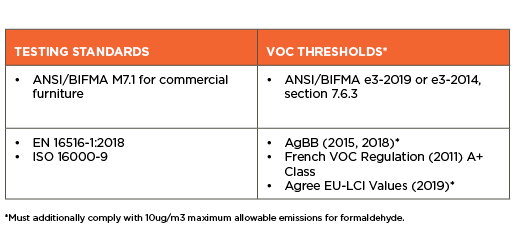CDPH Standard Method v1.2-2017
The California Department of Public Health’s (CDPH) Standard Method v1.2-2017 is an emissions testing and evaluation standard intended to be applied to any product with the potential to emit VOCs generally used within the envelope of an enclosed indoor environment that can be tested whole or by representative sample in environmental chambers. This method specifies target chemicals and their maximum allowable concentrations.
Evaluation of Products with Potential VOC Emissions
Interior building products with the potential to emit VOC and that are intended for installation within the building envelope (defined as interior of the wall vapor barrier and roof vapor barrier) must demonstrate emissions testing to the CDPH Standard Method v1.2-2017, or other ILFI-approved product emissions Testing Standards (see Table 10-3) and comply with individual VOC Thresholds established in the Testing Standard.
Interior site-installed, wet-applied products (e.g., paints, coatings, adhesives and sealants) are also held to the CDPH emissions testing requirements of this Imperative, in addition to meeting VOC content limits as required by Imperative 13, Red List.
Approved Alternatives to CDPH Standard Method for VOC Emissions
The information below contains additional international testing standards and reference methods that ILFI has approved as comparable achievement to the CDPH v1.2-2017 requirements and associated VOC emissions limits. All interior products with the potential to emit, including wet-applied products, that do not meet CDPH compliance must be third-party tested at an ISO 17025-certified laboratory by one of the following acceptable standards, and meet the VOC thresholds listed below. (Products manufactured in, having a final point of assembly in, and distributed within the Oceania region, defined as Australia, New Zealand, Melanesia, Micronesia, and Polynesia, may also use HH-005: Product Air Testing in Oceania.
These standards and protocols may include different testing methods, parameters, and chamber sizes, among other parameters, but are considered comparable to CDPH methods and VOC emissions limits for the requirements of this Imperative and for the purposes of the Living Building Challenge. However, interior products using these standards and thresholds must additionally comply with a maximum emission concentration of 10 μg/m³ for formaldehyde, as is required for CDPH compliance.
Table 1: Alternative Compliance for Interior Products

Table 2: Alternative Compliance for Furniture

Need more help with this?
Don’t hesitate to contact us here.



